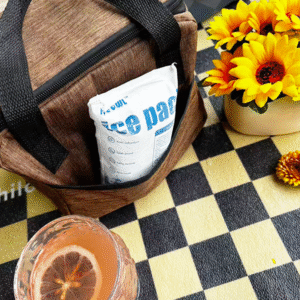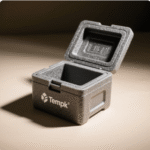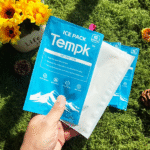Pengiriman barang yang mudah rusak memerlukan kontrol suhu yang tepat. Es kering untuk paket es kering yang lebih dingin menawarkan solusi pendinginan yang unggul, mempertahankan suhu di bawah nol tanpa meleleh ke dalam air. Panduan ini akan memandu Anda memahami pentingnya menggunakan es kering, memastikan barang Anda tetap dingin, segar, dan aman selama transportasi.

Apa Itu Paket Es Kering untuk Pendingin?
Paket es kering adalah blok padat karbon dioksida (Co₂) yang memberikan pendinginan yang konsisten dalam kontainer atau pendingin pengiriman. Tidak seperti es biasa, es kering menyublim langsung menjadi gas CO₂, tidak meninggalkan cairan. Pada suhu -78,5°C (-109.3° f), es kering mempertahankan suhu yang jauh lebih dingin daripada es atau kemasan gel, membuatnya sempurna untuk barang-barang sensitif seperti vaksin, hidangan laut, dan biologi.
Bagaimana Cara Kerja Es Kering di Pendingin?
Es kering bekerja dengan melepaskan energi dingin melalui sublimasi. Tidak seperti es tradisional, yang meleleh ke dalam air, es kering menghindari kerusakan air dan mempertahankan suhu yang jauh lebih rendah untuk jangka waktu yang lebih lama. Saat es kering menyublim, itu langsung berubah menjadi gas, memastikan isi pendingin tetap beku. Properti ini membuat es kering ideal untuk pengiriman jarak jauh dan menyimpan barang yang mudah rusak, karena memberikan rasa dingin yang konsisten tanpa kekacauan es yang mencair.
Manfaat Menggunakan Es Kering untuk Paket Pendingin:
-
Durasi pendinginan yang lebih lama: Es kering bertahan lebih lama dari es tradisional, menjaga barang tetap dingin untuk waktu yang lama, yang ideal untuk perjalanan jauh.
-
Tidak Ada Residu Air: Karena es kering menyublim menjadi gas, tidak ada risiko air merusak barang atau kemasan.
-
Penggunaan Ruang yang Efisien: Es kering membutuhkan lebih sedikit ruang dibandingkan es tradisional, menyisakan lebih banyak ruang untuk produk Anda.
-
Lebih baik untuk Item Sensitif: Es kering sangat penting untuk barang yang memerlukan presisi, suhu sangat rendah seperti vaksin, Sampel biotek, atau makanan khusus seperti makanan laut.
Panduan langkah demi langkah: Cara Menggunakan Es Kering untuk Paket Pendingin
Menggunakan es kering dalam pendingin adalah proses yang mudah, namun memerlukan penanganan khusus untuk menjamin keamanan dan efektifitasnya. Berikut cara mengemas dan menangani es kering di dalam pendingin dengan benar.
Melangkah 1: Pilih pendingin yang tepat
Saat memilih pendingin, faktor terpenting untuk dipertimbangkan adalah isolasi dan ventilasi. Pendingin berkualitas tinggi, seperti yang dari YETI atau Grizzly, membantu mempertahankan udara dingin, meminimalkan sublimasi dan memperpanjang umur es kering.
-
Isolasi: Insulasi tebal mengurangi laju sublimasi es kering. Pendingin yang terisolasi dengan baik memastikan es kering Anda bertahan lebih lama dan mempertahankan suhu yang konsisten.
-
Ventilasi: Es kering disublimasi menjadi gas karbon dioksida, yang dapat meningkatkan tekanan di dalam pendingin. Pastikan pendingin Anda memiliki lubang ventilasi yang baik agar gas dapat keluar dengan aman.
Melangkah 2: Tangani es kering dengan aman
Es kering sangat dingin dan memerlukan penanganan yang hati-hati untuk menghindari cedera. Selalu kenakan sarung tangan berinsulasi atau gunakan penjepit saat menangani es kering untuk mencegah radang dingin. Untuk pengiriman lebih besar, pastikan es kering dikemas dengan aman untuk menghindari pergerakan apa pun yang dapat merusak barang Anda selama transit.
Melangkah 3: Kemasi Barang dan Es Kering
Setelah Anda menyiapkan pendingin Anda, saatnya mengemas es kering dan barang-barangnya bersama-sama. Berikut cara melapisi pendingin Anda untuk efisiensi maksimum:
-
Lapisan bawah: Tempatkan es kering di bagian bawah pendingin, karena udara dingin secara alami tenggelam.
-
Lapisan Penghalang: Tambahkan selapis koran atau karton di atas es kering untuk mencegah kontak langsung dengan barang. Ini akan membantu melindungi barang-barang sensitif dari suhu dingin yang ekstrim.
-
Lapisan atas: Tempatkan barang-barang Anda yang beku atau mudah rusak di atas penghalang. Pastikan barang-barang dikemas rapat untuk meminimalkan ruang udara dan mencegah fluktuasi suhu.
Melangkah 4: Tutup Pendinginnya
Setelah pendingin dikemas, tutup rapat dengan aman. Namun, jangan menutupnya dengan kedap udara. Gas karbon dioksida memerlukan jalan keluar untuk menghindari penumpukan tekanan yang dapat menyebabkan pendingin meledak. Jika pendingin Anda memiliki sumbat pembuangan, biarkan sedikit terbuka untuk ventilasi.
Melangkah 5: Pantau suhu
Untuk pengiriman sensitif, merupakan praktik yang baik untuk memantau suhu internal selama transit. Perangkat pemantauan suhu, seperti pencatat data atau sensor nirkabel, dapat memberikan pembaruan waktu nyata dan memastikan suhu tetap dalam kisaran yang diinginkan.
Melangkah 6: Buang Es Kering dengan Aman
Setelah es kering menyublim, buang dengan aman di tempat yang berventilasi baik. Jangan pernah membuang es kering dalam wadah tertutup, karena penumpukan gas dapat menyebabkan ledakan.
Praktik Terbaik Menggunakan Es Kering untuk Pendingin
Untuk memanfaatkan es kering secara maksimal untuk kiriman Anda, Pertimbangkan praktik terbaik berikut:
-
Rencanakan Sublimasi: Es kering menyublim dengan kecepatan sekitar 5-10 pound setiap 24 jam. Selalu hitung berapa banyak es kering yang Anda butuhkan berdasarkan takaran ini untuk memastikan es kering tersebut bertahan selama jangka waktu yang dibutuhkan.
-
Pantau Sensitivitas Suhu: Untuk item yang sangat sensitif, seperti obat -obatan, sangat penting untuk menjaga suhu yang benar. Gunakan sensor suhu atau pencatat data untuk memastikan kondisi tetap dalam kisaran yang ditentukan.
-
Rencana Ventilasi: Selalu pastikan bahwa pendingin memungkinkan pelepasan gas yang tepat. Jika Anda mengirimkan es kering dalam jumlah besar, pertimbangkan untuk menggunakan wadah yang dirancang khusus untuk menampung karbon dioksida.
Es kering vs.. Paket Gel vs. Es biasa: Mana yang terbaik?
| Fitur | Es kering | Paket gel | Es biasa |
|---|---|---|---|
| Suhu | -109.3° f (-78.5° C.) | Bervariasi, biasanya 32°F-0° f | 32° f (0° C.) |
| Durasi pendinginan | 12–24 jam atau lebih | 1–3 hari tergantung jenisnya | 1–10 hari tergantung pada pendinginnya |
| Residu | Sublimat ke gas, tidak ada cairan | Meninggalkan residu gel | Meleleh ke dalam air |
| Penggunaan yang ideal | Barang beku, vaksin, hidangan laut | Pendinginan jangka pendek | Minuman, perjalanan singkat |
Es kering sangat ideal untuk situasi yang memerlukan suhu di bawah nol dan pendinginan yang lama, seperti mengangkut daging beku, hidangan laut, atau obat -obatan. Sebaliknya, paket gel lebih baik untuk kebutuhan pendinginan sedang, seperti pengiriman minuman atau barang mudah rusak yang tidak memerlukan suhu beku.
Pertanyaan yang sering diajukan (FAQ)
Q1: Berapa banyak es kering yang saya perlukan untuk pendingin 25 liter?
Pedoman standar adalah dengan menggunakan 10 ke 15 pon es kering per hari. Untuk pendingin 25 liter, ini seharusnya cukup untuk perjalanan 1-2 hari.
Q2: Bisakah saya menggunakan es kering untuk pengiriman makanan?
Ya, es kering biasanya digunakan untuk pengiriman makanan yang mudah rusak, terutama yang membutuhkan suhu di bawah nol, seperti makanan laut atau makanan beku.
Q3: Berapa lama es kering bertahan dalam pendingin?
Es kering biasanya bertahan 12–24 jam dalam pendingin berinsulasi, tergantung pada jumlah yang digunakan dan suhu eksternal.
Q4: Bisakah saya membuang es kering ke tempat sampah?
TIDAK, es kering harus dibiarkan menyublim di tempat yang berventilasi baik. Jangan sekali-kali membuangnya ke dalam wadah tertutup atau tempat sampah karena dapat menyebabkan ledakan.
Kesimpulan
Es kering untuk paket es kering yang lebih dingin adalah solusi yang efektif dan andal untuk pengiriman barang yang sensitif terhadap suhu. Dengan memahami cara kerja es kering, cara menanganinya dengan aman, dan cara mengemasnya secara efisien, Anda dapat memastikan barang Anda tetap segar dan aman selama transit. Apakah Anda mengirim makanan, Farmasi, atau sampel biotek, es kering memberikan solusi yang tidak ada duanya untuk logistik rantai dingin.
Untuk hasil yang optimal, rencanakan ke depan, hitung kebutuhan es kering Anda, dan menggunakan wadah dan tindakan keselamatan yang sesuai.























